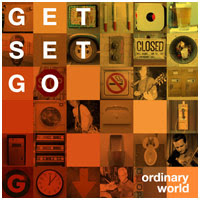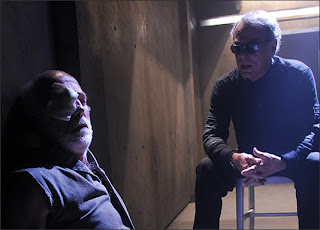 Get Set Go lives for contradictions. They lace their cartoonish, home-made, indie-rock melodies with Kurt Cobain anxiety and peddle it to the masses. Their golden retriever approachability bears no relation to their Los Angeles origins; nor does the grey minivan outside with taped windows.
Get Set Go lives for contradictions. They lace their cartoonish, home-made, indie-rock melodies with Kurt Cobain anxiety and peddle it to the masses. Their golden retriever approachability bears no relation to their Los Angeles origins; nor does the grey minivan outside with taped windows.Yet, perhaps the strongest contradiction rests within their audience. In the cluttered café section of an Athens, Ga., Borders, a clear voice sang loudly, "I might set my house on fire/ hang myself from the telephone wire/ bomb the trade center/ and crash all the trains," as children bounced around with crazed excitement. Oh yes, Get Set Go lives for contradictions.
Indie music stands as the red flag of defiance. Therefore Borders and Get Set Go obviously seem like an odd amalgamation of subculture with mainstream. It compares to discovering your friendly neighbor who always lends out an extra bag of Folgers also hands out the neon glow sticks at the club.
Though, maybe nowadays the pairing isn’t so odd. With popular bands like Fall Out Boy and The All-American Rejects on the scene, obscure indie-rock now translates as mainstream and even sexy. Toss on some skinny jeans, an unpretentious vintage T-shirt and lightly grease the hair of that stick figure kid in your biology class and there’s your personalized Pete Wentz or Tyson Ritter.
I can’t help but envision the corporate grin of some wrinkled Borders exec at the thought of attracting all those young hipster kids with a little indie music. Since the inception of Borders superstores in the early 1990s, the clash of emo kids and capitalism seemed inevitable.
Get Set Go welcomes the hybrid with tails wagging. No longer in their idealistic early 20s, each of the members appears to have made their peace with corporate conformity a long while ago. Exposure equals exposure and so here they stand: an arrangement of five indie-rock guys beamed in, via L.A., from the shit-can-fly schemes of aging Borders execs on a mission to bring EmoBack.
They play like a machine constructed by the fourth and justifiably estranged Animaniac. They run through their bars and quarter notes at breakneck speed. At first, one half expects them to run off a musical cliff into reckless abandon only to float into the air for a few minutes before they realize they’ve missed the mark by a few kilometers. And slowly I realize their immense contentment with floating through the air in complete, self-imposed denial.
A few stopping points or lyrical edits on their song “Die Motherf***er Die,” for instance, may have been more appropriate. I recommend somewhere before “my day sucks ass” and yet after “I wanna hurt you/ torture than desert you” and excluding the entire chorus, “Die Motherf***er Die.”
Eric Summer, the viola player, redeems the band’s impetuousness with his layered and soulful sound. The strings calm the audience like sedatives while the rest of the band pushes forward contemplating take off.
If one leaps into their melodic and upbeat notes, Get Set Go, for the most part, sounds live the very early stages of an acoustic Weezer attempting to channel the Ramones.
The lead singer, Mike TV, resonates with the appropriate amount of arrogance and overcompensation for his slim 5’4 frame. Mastering the art of over-articulation, his “s” and “t” nearly poke you in the eye and his “o’s” overflow. He’s even got the Oscar “I’ve suffered injustice” pout. His brunette shaggy bangs cover his eyes at all the right moments. He’s got the moody bangs for his song “Suicide,” and moves them over slightly to reveal one sulking brown eye for the acoustic stalker ballad “Won’t Let Her Go.”
If a bassist falls in the middle of a crowded Borders café does anyone notice? Questions like this tend to arise when observing the statuesque Colin Schlitt, the bassist who never moves; with the slight exception of his wire-thin fingers and strained facial expressions. He stands in odd contrast to the over-animated lead TV.
At last, Get Set Go finishes their short set to a thunderous applause of children. Their second album “Ordinary World,” enjoyed the most live play while their first LP “So You’ve Ruined Your Life” took a backseat. A 5-year-old tugs his mother’s Prada bag towards the countertop candy while singing loudly “I hate everyone.” They lyrics stemmed from the band’s most successful track “I Hate Everyone,” which also landed a spot on last season’s Grey’s Anatomy.
Get Set Go exudes an interesting combination of college angst and Sesame Street melodies. It’s easy to envision a big yellow bird, with a college shirt, posted in the corner of on of their club shows with an obscure cloud of smoke around him. The band appeals to our simple happy natures despite their melancholy lyrics. After buying a $10 “Ordinary World” album, I find myself humming upbeat, catchy songs of desperation with utter delight. And I would pay for more. Bottom line, Get Set Go is light, sarcastic and amusing in the right venue, ripe with wonderful contradictions.
Get Set Go on the web:
www.getsetgomusic.com
myspace.com/getsetgo.







